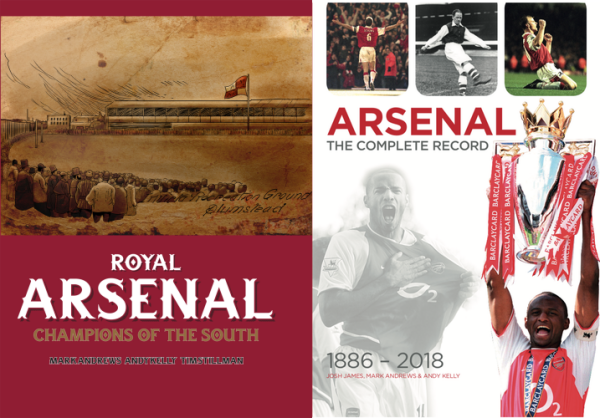Arsenal League Champions 1937-38
In the 1930s Arsenal won the League five times: 1930-31, 1932-33, 1933-34, 1934-35 and 1937-38.
Two of these triumphs were gained at home. This, the second, was against Bolton Wanderers.
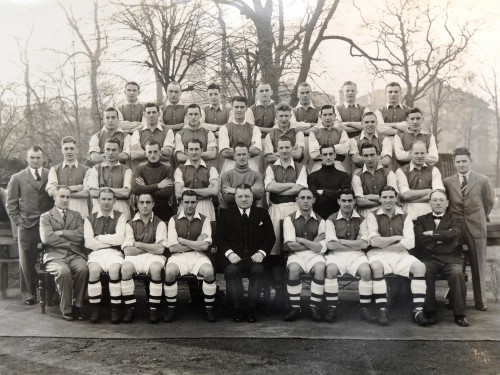
1937-38 The Arsenal team photograph.
Date: Saturday 7 May 1938
Competition: Football League Division One
Location: The Arsenal Stadium, Highbury
Attendance: 40,500
Arsenal (3) 5 Goalscorers: Kirchen, Carr 2, Bastin 2
Bolton (0) 0 Goalscorers:
Line-ups:
Arsenal: G Swindin, G Male, E Hapgood (captain), L Jones, B Joy, W Copping, A Kirchen, G Bremner, E Carr, G Drury, C Bastin.
Bolton: S Hanson, J Tennant, H Hubbick, H Goslin, J Hurst, G Taylor, T Woodward, T Grosvenor, J Currier, R Westwood, D Howe.
Title race résumé
The final round of matches of the season began with Wolves top of the League by a point. Arsenal had to win or draw and hope Wolves did not match the Gunners’ result to gain the title.
| Pos | Team | P | W | D | L | F | A | GA | Pts |
| 1 | Wolverhampton Wanderers | 41 | 20 | 11 | 10 | 72 | 48 | 1.5 | 51 |
| 2 | Arsenal | 41 | 20 | 10 | 11 | 72 | 44 | 1.64 | 50 |
| 3 | Preston North End | 41 | 16 | 16 | 9 | 64 | 44 | 1.46 | 48 |
The Arsenal v Bolton match was a 3:30 kick off while the Sunderland v Wolves game was to start at 3:15.
As it was Arsenal won 5-0, while Wolves lost at Sunderland handing the title to the Gunners for the fifth time in eight seasons. Had Wolves managed to draw the title still would have come to Highbury on goal average. Raich Carter scored for Sunderland in the seventh minute of the game at Roker Park, before even the Gunners had even kicked off in North London.
Match
Arsenal went ahead quickly after a miskick from full back Jack Tennant was pounced upon by Alf Kirchen to ease any worries the crowd or players would have had.
Eddie Carr then hit two in the latter stages of the second half with crisp shots to ensure victory.
In the second half the Gunners turned on the afterburners for what was effectively an exhibition and Bastin scored a brace. However, his second was another disaster for Tennant who managed to help the ball past Stan Hanson in the Bolton goal.
Bolton were totally outplayed as their full backs Tennant and Harry Hubbick, together with centre half Jack Hurst, had games they would wish to forget.
Any Bolton assault was snuffed out by the defence, in which George Male especially was magnificent, and behind him George Swindin’s safe hands ensured a clean sheet.
This was the only time in the 1930s that Arsenal had left the completion of the title as late as the final game. In truth, Wolves let the title slip with a number of unexpected home points dropped in the run in and Arsenal slipped into their slipstream to triumph.
In all truth the game was too one sided to be memorable and there was far more excitement on the pitch at the final whistle.
After the match celebrations at Highbury
Imagine the Highbury enclosure at a minute to five o’clock on Saturday. Arsenal had the game won, while Wolves were losing at Sunderland. Any minute the result of their rivals’ game would come through.
Every eye was turned towards the score-board. Then, a few minutes before the end of the game, the Wolves result was flashed around Highbury. The rest of the match was played to a constant roar of cheering and shouts.
At the final whistle many spectators jumped over the railings with the aim of chairing each of the League Champions off the pitch, but a combination of mounted and ground police ensured a path was kept for the players to get to the safety of the dressing-rooms before the gleeful mass encircled them.
All except Eddie Hapgood. In a moment he was swept up and found himself being held aloft by a seeming mass of heads as the crowd shouldered him to the stands and once there he made his way to the dressing rooms.
The crowd got to the area in front of the grandstand, they were calling for the men who had gained the title. Amongst massive crowd scenes the loudest call went up for Carr. “We want Carr, We want Carr” chanted the fans.
After their initial success the police were powerless to stop the onward surge of the crowd, which became bigger every moment. The Arsenal band leader began “Auld Lang Syne” the crowd sang it, but they still went on jostling for positions to see the players.
Then the strains of the National Anthem rang out over that pushing, shouting stream of humanity and instantly the shouting died, the pushing ceased and hats were whipped off. The pitch invaders stopped, and as one great choir they all took up the song.
The mass evaporated quickly once sated with seeing the players and a good old sing song. the singing and carousing was to carry on well into the night in the Islington pubs and streets.
Links to the match or players:
Ted Drake, the centre forward, sat in the stand while his team-mates played the win-or-lose-championship game. Drake injured his hand and head over Easter but after turning out the previous Saturday the doctors insisted on another week’s rest.
Carr took his place and managed 5 goals in the final 3 games of the season, all of which were won. Indeed Carr played so well at centre forward that Drake, in the one game he was fit to play, was slotted in at right wing. Sadly for Carr his promising career at Arsenal was ruined first by serious injury and then the war.
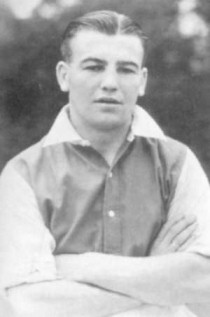
Eddie Carr
Drake, a legend at Arsenal for his late 1930s goal scoring feats, was also the first Chelsea manager to win the League title. His 1955 triumph was the only time the Blues won the League before the oil money turned up.
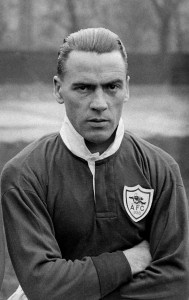
Bob John
Veteran Bob John was not retained for the next season. He had not played at all during this season and had been with the club since 1922. In the summer of 1938 he went onto coach at West Ham.
Herbie Roberts, too, stopped playing at the end of the season. He found a role at Arsenal in coaching in the summer of 1938 having played for the club since 1927.
Joe Hulme retired from playing just over two weeks after Arsenal’s League win. He had moved to Huddersfield after playing in all the other 1930s Arsenal trophies wins.
Future Gunner and post World War 2 scoring sensation Ronnie Rooke notched a hat-trick for his club Fulham.
A day after this match the newspapers were full of reports that Arsenal were looking to bolster the attack and purchase Bryn Jones from Wolves. Allison did sign him in the close season for a world record £14,000 but a slow start and the war intervention rather blighted his time at Arsenal.
Stan Hanson the Bolton keeper remained with the club until the mid-50s and kept in goal for them in the 1953 FA cup final, or as it is frequently referred to: the “Matthews final”
Harry Goslin was killed in the Italian campaign in 1943. He was the only Bolton player to lose his life during World War 2.
Facts relating to the 1937-38 season:
Eddie Hapgood was presented with the trophy. It was the only one he received as captain after replacing Alex James. This was Hapgood’s first season as captain and he remained as captain well into the war until he left to manage Blackburn.
The Championship dinner was held in the summer on the evening of 13th August 1938 at the Cafe Royal. As the reserve team had also won the London Combination title, losing only 3 times in 46 games, the winners medals for both competitions were presented to the players. The players of Arsenal’s nursery team, Margate, received Kent League medals too!
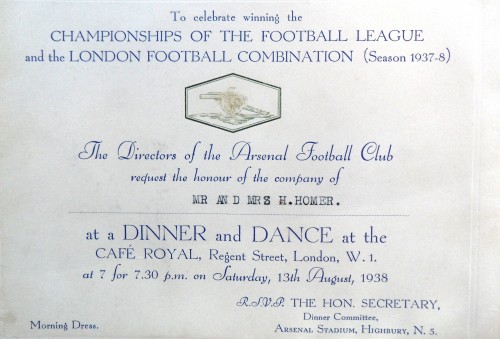
Celebration Dinner and Dance: courtesy of Arsenal museum
The Arsenal side received a proportion of a pot of £275 to be shared between them from the Football League for the win, based on how many games each had played. As an amateur Bernard Joy received a golf bag.
In the FA Cup, Arsenal defeated both today’s protagonists – Bolton and Wolves – before succumbing to the eventual winners Preston in the fifth round.
According to various reports the Gunners were quite unpopular with the rest of the country by now, as they still won trophies despite having their famously classic team including James, Hulme and Jack replaced.
After this win the team travelled immediately for Holland to play Feyenoord on the next day. They lost 1-0 in front of 50,000.
This was the final League title win for Arsenal in the 1930s; and the club was severely hit by the war in both loss of life and destruction of parts of the stadium. But owing to the “boot room” Chapman built, Whittaker was able to pick up where Allison left off and win the League in the second season after the war.
Sources
Daily Mirror
Sunday Times
Arsenal museum collection: Harry Homer material
The Arsenal History Line-Ups microsite
Fred Ollier: Arsenal the Complete Record.
—————–
Don’t forget to subscribe to the blog (top right). You know it makes sense.
Or have a look at our other site: The Arsenal Collection for more Arsenal memorabilia.
Copies of our books Royal Arsenal – Champions of the South and Arsenal: The Complete Record 1886-2018 are still available from the publishers.
